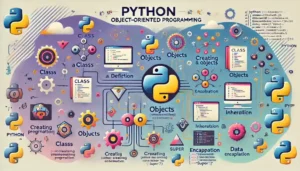Object-oriented programming (OOP) in Python provides powerful tools to structure your code efficiently, making it reusable, maintainable, and intuitive. By defining classes and objects, you model real-world entities with attributes and behaviors clearly. Key concepts such as inheritance, encapsulation, polymorphism, and abstraction enhance the versatility of your code, enabling you to create complex programs with ease and clarity.
In this exercise set, you’ll master Python classes, methods, and inheritance structures, learning to encapsulate data, override methods for polymorphic behavior, and create custom constructors and destructors. Understanding these OOP principles positions you effectively for developing robust applications and contributes to your growth as a professional Python developer.
🚀 Jump Right to Exercise Tasks: Python Exercises – Object-Oriented Programming
Classes, Objects, and Attributes
A class in Python is like a blueprint for creating objects. Objects are instances of classes that hold data attributes. For example, a Car class can store attributes like make and model, representing real-world properties of vehicles.
Practical Example
Create a class that defines a car and initialize it with make and model attributes. Then, print these attributes to verify they’re correctly assigned.
class Car:
def __init__(self, make, model):
self.make = make
self.model = model
my_car = Car('Toyota', 'Corolla')
print(my_car.make, my_car.model)Example Solution:
Toyota CorollaKey Takeaways:
- Classes provide structure and reusability.
- Objects store attributes defined in classes.
- Initialization method
__init__sets attributes.
Inheritance and Method Overriding
Inheritance allows classes to inherit attributes and methods from parent classes. Subclasses can override methods to implement customized behaviors, enhancing flexibility and promoting code reuse.
Practical Example
Create a Car subclass ElectricCar, override its drive method to demonstrate polymorphism, and print a customized driving message.
class Car:
def drive(self):
print('Vroom!')
class ElectricCar(Car):
def drive(self):
print('Silent Vroom!')
ec = ElectricCar()
ec.drive()Example Solution:
Silent Vroom!Key Takeaways:
- Inheritance promotes reusable and maintainable code.
- Method overriding enables customized subclass behavior.
- Polymorphism allows subclasses to behave differently from their parents.
Encapsulation and Access Control
Encapsulation restricts direct access to object attributes, promoting data integrity. Python implements encapsulation using private attributes and property decorators, allowing controlled access through getters and setters.
Practical Example
Implement encapsulation with private attributes and provide getter and setter methods using property decorators.
class Car:
def __init__(self):
self.__speed = 0
@property
def speed(self):
return self.__speed
@speed.setter
def speed(self, value):
if value >= 0:
self.__speed = value
car = Car()
car.speed = 60
print(car.speed)Example Solution:
60Key Takeaways:
- Encapsulation ensures data protection.
- Private attributes prevent direct modification.
- Properties control attribute access safely.
What You’ll Gain from Completing This Exercise
Completing these Python OOP exercises will solidify your understanding of classes, inheritance, encapsulation, and polymorphism. You’ll learn to design maintainable, scalable, and efficient code structures, essential for real-world Python development projects.
How to Complete the Exercise Tasks
Use the interactive Python editor provided below each task:
- Write your Python code: Enter your solution into the editor.
- Run your code: Click “Run” to execute your solution and view the output.
- Check your solution: Verify your code’s correctness against provided tests.
- Reset the editor: Click “Reset” to clear and retry your solution.
Earn XP, Unlock Rewards, and Track Progress!
If logged in, completing tasks earns XP, unlocks new levels, unique Avatars and Frames, and boosts your leaderboard position. Your progress saves automatically!


